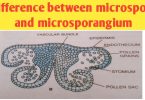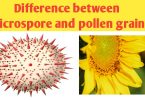What is difference between primary and secondary pollutants l definition and examples of primary pollutants l definition and examples of secondary pollutants.
As you know with increase in human population and great advancement in technology in the recent past, the wastes materials have multiplied in amount as well as in kind, and this has resulted in contamination of environment.

What is difference between primary and secondary pollutants
The contaminated of environment is called pollution, the substances which make the environment foul are called pollutants, an according to form in which pollutants persists after release into the environment, the pollutants are categorise into primary pollutants and secondary pollutants.
How does primary pollutants differ from secondary pollutants?, when you compare between primary pollutants and secondary pollutants, primary pollutants persists in the form in which they are added to the environment while secondary pollutants are formed by interaction among the primary pollutants. For example Sulphur dioxide SO2 is primary pollutants reacts with water vapours in atmosphere to form a secondary pollutant sulfuric acid H2SO4.
Hi guys in this article we know about definition of primary pollutants and secondary pollutants with examples and compare/differences/ distinguish/ contrast between primary pollutants and secondary pollutants.
Definition of primary pollutants
Definition of primary pollutants:- the pollutants which persists in the form they are added to the environment are called primary pollutants. For example plastic ware , exhaust of carbon monoxide gas CO and CO2 from motor vehicle, sulphur dioxide SO2 released from factories, ash from a volcanic eruption etc are primary pollutants.
Definition of secondary pollutants
Definition of secondary pollutants :- the pollutants which are formed by interaction among the primary pollutants are called secondary pollutants, this type of pollutants are not emitted directly in the atmosphere.
For example, ground level ozone , peroxyacyl nitrate (PAN), HNO3, H2SO4 are secondary pollutants.
You can also click on the given link to see others topic in our website and YouTube channels
◆ ALSO READ: HEART ANATOMY, PHYSIOLOGY, LOCATION, DISEASE & TREATMENT
What is difference between primary pollutants and secondary pollutants
This question is very important for class 8th,9th,10th and 12th students and those preparing for competitive and annual board examinations.
As you all know that an air pollutants is a material in the air that can have adverse effects on human, atmosphere and the ecosystem, pollutants can be solid particles, liquid droplets, or gases.
Regarding this, “what is difference between primary pollutants and secondary pollutants”, generally, primary pollutants are produced by human activities directly and they persists in the form in which they are added to environment, carbon dioxide (CO2), Sulphur dioxide (SO2), nitrogen dioxide (NO2) and volatile organic compounds etc are primary pollutants while secondary pollutants are formed by interaction among the primary pollutants, these are more toxic than primary pollutants, smog, PAN are important secondary pollutants.
Comparison/ difference between primary and secondary pollutants are as follows:-
Primary pollutants:-
1. Air pollutants emitted directly from the source are primary pollutants.
2. The primary pollutants sources are either natural process such as sandstorms and volcanic eruptions or anthropogenic (human activity) such as industrial and vehicles emissions.
3. Primary pollutants are found in the atmosphere in the form they are emitted from the source, they are found in the form of particulate matter, aerosol, reduced or oxidised forms.
4. Primary pollutants are less toxic.
5. Chemical reactants characterized with a direct effect on living beings and ecosystem
6. Primary pollutants are sulphur dioxide, carbon monoxide, nitrogen oxides and particulate matter.
7. The effects of primary pollutants are of concern as they can be harmful to human, animals and plants
8. Primary pollutants contributes in the formation of secondary pollutants.
9. The emissions of primary pollutants has decreased considerably due to improved regulations, technology and economic changes.
10. Controlling primary pollutants can be done directly by reducing anthropogenic emissions.
Secondary pollutants:-
1. Secondary pollutants are not emitted directly from the source but are formed due to chemical reaction.
2. Air pollutants formed in the atmosphere as a result of the chemical or physical interaction between the primary pollutants themselves or between the primary pollutants and other atmosphere components are secondary pollutants.
3. Secondary pollutants are found in the oxidised forms.
4. The phenomenon of increased toxicity by reaction among the pollutants is called synergism which is more in secondary pollutants than primary pollutants.
5. Chemical products, highly reactive when photoactivation is involved in the chemical process of their formation, secondary pollutants are more harmful and devastating for ecosystem and living beings.
6. Secondary pollutants are peroxyacyl nitrate,ozone, aldehydes, photochemical smog etc.
7. The effects of secondary pollutants cause skin cancer due to ozone gas.
8. Secondary pollutants form naturally from interaction between primary pollutants and cause problem like photo chemical method.
9. The emissions of secondary pollutants has increased due to less reaserch and development on it.
10. Controlling secondary pollutants quite complicated since it involves studying the process of its creation and needs more advanced technology to control it.
Conclusions:-
Both primary and secondary pollutants contaminate the atmosphere and ecosystem, there are certain differences between them, it is duty of every one to take adequate measures and required of advance technology research and innovation to control the formation and emission primary and secondary pollutants.







Leave a Comment